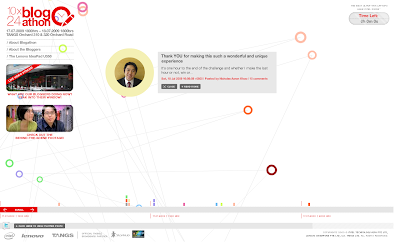 In July 2009, Intel launched a new range of ultra-low-voltage processors that enable PC brands to build ultra-thin notebooks offering long battery life and sophisticated processing capabilities in an easily portable form.
In July 2009, Intel launched a new range of ultra-low-voltage processors that enable PC brands to build ultra-thin notebooks offering long battery life and sophisticated processing capabilities in an easily portable form.Objective: Intel wanted to demonstrate these lifestyle benefits more than ever…
Strategy: Intel tapped Singapore’s most influential tech and fashion bloggers to generate a profile for a visually uninspiring, but technologically exciting, product. Top 10 famous tech bloggers from Singapore were prepared to embark on a live 24-hour, non-stop, Intel-powered ‘Blogathon’.

Vision
1) Create maximum visibility for the slimline notebooks fitted with Intel’s range of ultra-low-voltage processors;
2) Bring the chip to life for consumers by making it relevant to their lifestyles;
3) Educate consumers on the performance of the Intel Core 2 Solo chip.
Execution plan (17 July - 18 July)
Hardware provider (Laptops): Lenovo
Sponsor (design and appearence): Singaporean fashion brand TANGS
Selection process of bloggers: An intensive audit was conducted to identify relevant, influential bloggers to participate in the event. An equal percentage of both ‘tech geeks’ and ‘fashionistas’ were engaged with a view to expanding brand equity between both groups.
Media channels & platforms
Youtube.com: A reality-TV-style video was aired on YouTube four days before the launch. It also served as material for the participants to include in their blogs. The video revealed the bloggers’ initial thoughts about the challenge alongside a sneak preview of their makeover experience at TANGS.
Microsite: A Flash-based microsite with blog aggregator was created to inspire the bloggers to create content over the 24-hour period.
Analytics: A tracking system was integrated on the microsite to ensure precise measurements usually unattainable in a blogger engagement programme (such as measuring the time spent per visitor on average per blog post).
BTL/On-ground support: To maintain a high level of interest during the event, attract on-ground traffic, and maintain a constant level of dialogue, real-time Twitter conversations were aired on LCD TV screens placed in each window display; a product demonstration booth allowed shoppers to try out the Lenovo laptops used by the bloggers; and trained product specialists from Lenovo provided on-site education on the laptops and the capabilities of Intel’s Core 2 Solo processor.
Digital agency: Ogilvy 360º Digital Influence, Ogilvy Public Relations Worldwide, responsible for the live integration of the visual capabilities of Flash
Blog platform: Wordpress, content management system
After the event, a video summarising the highlights was posted on YouTube.
Results
Total hits on the micro-site: 3,705 people from 34 markets visited the microsite in five days; 88 per cent were from Singapore. The site helped build an organic database, with 353 votes cast on-site.
Total visitors / Blog participation: 3,958 unique visitors. A total of 140 blog posts were generated in 24 hours, averaging 5.8 blog posts per hour; 817 comments were posted in 24 hours, averaging 34 per hour. It was covered across eight news platforms, 51 external blogs, and a leading design portal, notcot.org.
With no prizes or activities created on the site to incentivise visitors, bloggers were challenged to create more engaging content than their rivals and to read and comment on posts. This resulted in 42,372 page-views in five days, averaging about 11.44 page-views per person; each visitor spent on average 12:04 minutes on the site, the equivalent of 24 30-second TV commercials watched consecutively in the same time period; the bounce rate was low at 32.42 per cent. Only three out of 10 visitors dropped out in under a minute, while around 10 per cent of visitors (300) viewed 20 pages or more.
Reference: Haymarket Media

